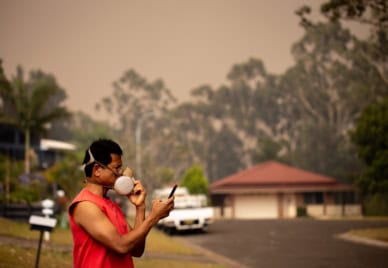
Aggregating and Integrating Data on Health Outcomes Associated with Bushfires at a National Scale
Exploreabout Aggregating and Integrating Data on Health Outcomes Associated with Bushfires at a National Scale
State and territory education departments hold rich information about various aspects of Australian students, including:
But while these data have a great potential to facilitate research, they are held in numerous custom-made databases that do not talk to each other, varying in terms of the content, detail, quality and governance. This makes it difficult for researchers to tap into them. In fact, with the metadata often missing, many researchers would not know the data exist in the first place. A curated data asset is needed to understand how our education system is performing and evaluate the efficiency of mental health interventions delivered at schools.
This project created an enduring database linking education and wellbeing data from multiple databases, covering such areas as enrollment, attendance, behaviour management, academic achievement, and student wellbeing. Over time, this will paint a fuller picture of the students’ journey throughout their school life. A collaborative, coordinated approach will maximise the comparability and use of all these data from different states and territories.
The project involved:
State-held data was assessed for their quality, the public interest in them, and their utility. A data harmonisation crosswalk document will be created from the metadata, and a FAIR data guideline implementation plan will be developed.
The data harmonisation crosswalk document was used for consultation with research advisory groups and end users. Key variables were selected, and potential harmonisation issues will be identified.
Partners curated their datasets in line with the final harmonisation document. The datasets were then transferred to the SA Department for Education to be cleaned and merged. Data access mechanisms will be finalised and tested.
Data is accessible to researchers via the Fraser Mustard Centre / SA Department for Education webpage in line with the FAIR guidelines. Metadata/data dictionary information is now available, and project outcomes are being tracked.
The project has delivered a dataset containing deidentified and aggregated linked student wellbeing data collected between 2014 and 2022 across South Australia, Tasmania, and the Australian Capital Territory. Data is from students from Years 4 to 12. The dataset is accessible via the UniSA Research Data Access Portal.
The project has delivered:
Ultimately, this project will enable high quality, policy-relevant research on young people’s wellbeing and engagement during their schooling years by combining existing wellbeing and engagement data with demographic, attendance, and NAPLAN data. This will be significant to young people’s education outcomes, adult outcomes, and the future of Australia’s economy.
This project will benefit:
The dataset is also accessible via ARDC Research Data Australia.
For more information, please read about the Wellbeing and Engagement Collection (WEC) and the Wellbeing and Engagement Census.
You can also view: